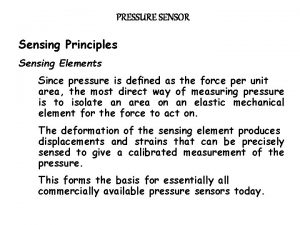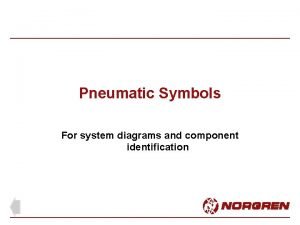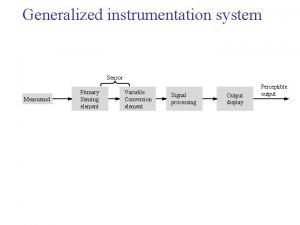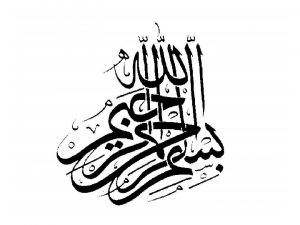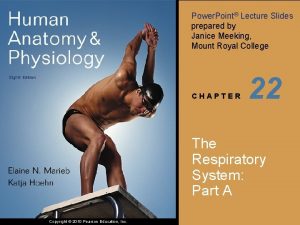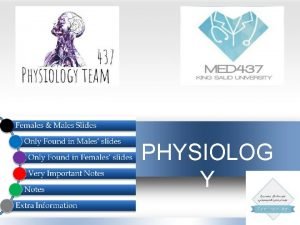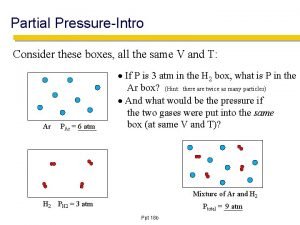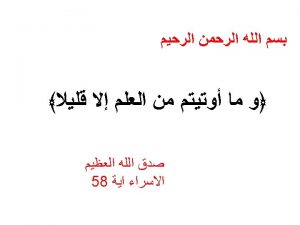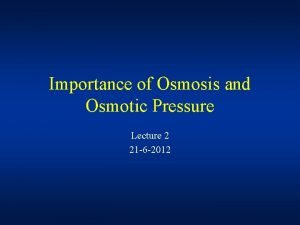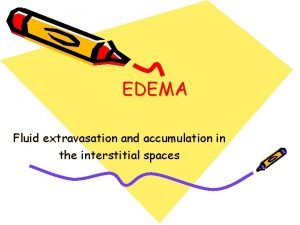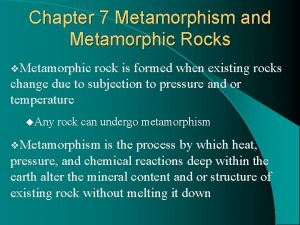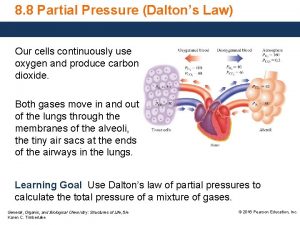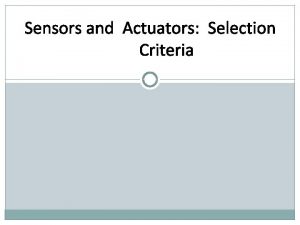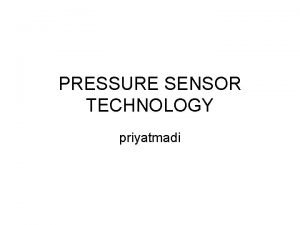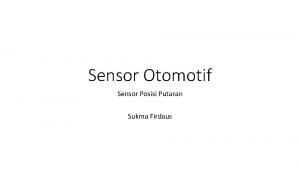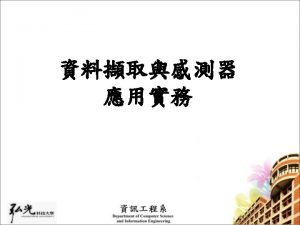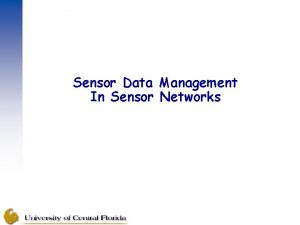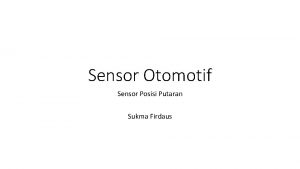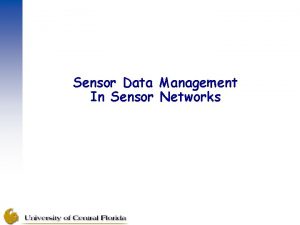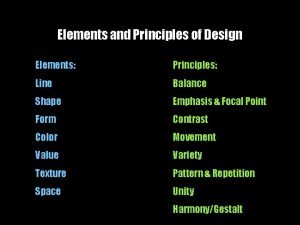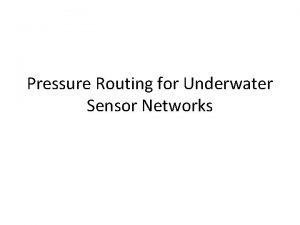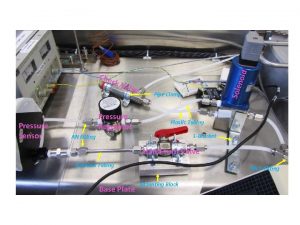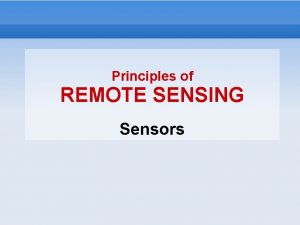PRESSURE SENSOR Sensing Principles Sensing Elements Since pressure





















- Slides: 21

PRESSURE SENSOR Sensing Principles Sensing Elements Since pressure is defined as the force per unit area, the most direct way of measuring pressure is to isolate an area on an elastic mechanical element for the force to act on. The deformation of the sensing element produces displacements and strains that can be precisely sensed to give a calibrated measurement of the pressure. This forms the basis for essentially all commercially available pressure sensors today.

PRESSURE SENSOR Can be grouped as diaphragms, capsules, bellows, and tubes as Figure Pressure-sensing elements: (a) flat diaphragm; (b) corrugated diaphragm; (c) capsule;

PRESSURE SENSOR Can be grouped as diaphragms, capsules, bellows, and tubes as Figure Pressure-sensing elements: (d) bellows; (e) straight tube; (f) C-shaped Bourdon tube;

PRESSURE SENSOR Can be grouped as diaphragms, capsules, bellows, and tubes as Figure Pressure-sensing elements: (g) twisted Bourdon tube; (h) helical Bourdon tube; (1) spiral Bourdon tube.

PRESSURE SENSOR Can be divided into three types: 1. Deflection type 2. Strain gauge type 3. Piezoelectric type

Typical Pressure Detector System

1. DEFLECTION TYPE PRESSURE SENSOR • This sensor uses an elastic material to convert pressure to displacement e. g. stainless steel, brass. • The displacement will be proportionate to the value of pressure exerted. • Suitable to be used in an automatic control system. • The main element used is in the shape of Bourdon tube, bellow or diaphragm. • The secondary element is the element that will convert the displacement to electrical signals where the displacement can be detected through resistivity change, inductance or capacitance.

The Main Typical Element Used In A Deflection Type Pressure Sensor

Basic Form of Mechanical Pressure Sensors

Example : i. Bellow-resistance pressure sensor • The pressure is proportionate to the resistivity. • The resistance change is detected by displacement of sliding contact in the resistance element. Bellows Calibrated spring Resistance Sliding contact Output Signal

Example : ii. Bellow-inductance pressure sensor • The pressure is proportionate to the inductance change which is detected from the displacement of the core in the wire coil. • The core movement will produce AC signal output which will give the value and direction of inductance. • LVDT (linear variable differential transformer) demodulator is used to convert the AC output to DC. Bellows Core Output Signal

iii. Diaphragm-capacitance pressure sensor • The pressure is proportionate to the capacitance change at the output through dielectric change. • Pressure from the sensor element causes the diaphragm to move towards the plate and produces dielectric change.

Resistance Type Capacitance Type

Capacitance Type

2. STRAIN GAUGE PRESSURE SENSOR • Strain gauge is a type of resistive transduction. • Pressure measurement is obtained from displacement of elastic element. • Pressure is measured through force that is exerted on the diaphragm where the force will be detected by the strain gauge and resistance change will be produced. • Wheatstone Bridge circuit is used to detect the change in pressure and an amplifier is used to amplify the small output signals.

Strain Gauge Pressure Sensor

3. PIZOELECTRIC PRESSURE SENSOR • This sensor consists of a piezoelectric crystal (made from quartz) which functions as a forcesensitive voltage source where the piezoelectric will be in between two plates. • Pressure exerted on the crystal surface is proportionate to the voltage produced by the crystal. • This sensor does not require any voltage supply. • This sensor is suitable for fast changing pressure measurement.

Mechanical Stress Piezoelectric Material Plate Output Voltage Mechanical Stress Piezoelectric Pressure Sensor

Piezoelectric Pressure Sensor

Piezoelectric Pressure Sensor

Units of Pressure and Conversion
 Pressure sensing elements
Pressure sensing elements Cummins isl9 crankcase pressure sensor location
Cummins isl9 crankcase pressure sensor location Chapter 17 drivers ed
Chapter 17 drivers ed Pneumatic components symbols
Pneumatic components symbols Generalized medical instrumentation system
Generalized medical instrumentation system Patella type 3
Patella type 3 Pressure support vs pressure control
Pressure support vs pressure control Pressure mapping for pressure ulcers
Pressure mapping for pressure ulcers Intrapulmonary pressure vs intrapleural pressure
Intrapulmonary pressure vs intrapleural pressure Starling's equation
Starling's equation Partial pressure
Partial pressure Clubbing fingers
Clubbing fingers How are metamorphic rocks classified
How are metamorphic rocks classified Pressure support vs pressure control
Pressure support vs pressure control Bernoulli equation pipe flow
Bernoulli equation pipe flow Oncotic pressure vs hydrostatic pressure
Oncotic pressure vs hydrostatic pressure Hydrostatic pressure vs colloid osmotic pressure
Hydrostatic pressure vs colloid osmotic pressure Oncotic pressure
Oncotic pressure Hydrostatic oncotic pressure
Hydrostatic oncotic pressure Dynamothermal
Dynamothermal Regulation of blood pressure
Regulation of blood pressure How to find partial pressure from total pressure
How to find partial pressure from total pressure
